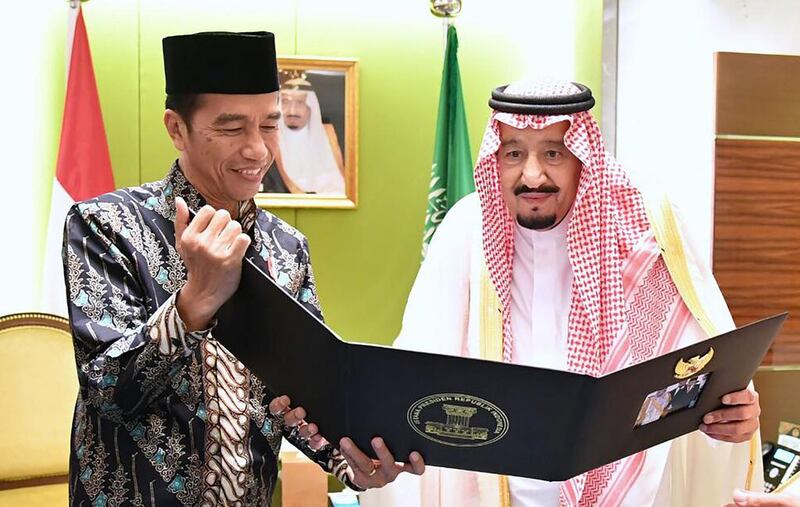King Salman’s tour of Asia is significant. The majority of Saudi Arabia’s non-oil exports end up there, as do two-thirds of its oil exports. The economic path and development of Asia will have a major effect on Saudi Arabia’s trade profile. The trip can be divided into two parts: South East Asia (Malaysia, Indonesia and Brunei) and the Far East (China and Japan).
Thus far, the trip has been led by Saudi Aramco’s investments in Indonesia and Malaysia, which amount to US$13 billion. This is understandable given the downstream strength that Saudi Aramco wants to build in Asia. Owning refineries in Asia is part of a long-term strategy to consolidate market share in this most important region.
Aramco plans to almost double its refining capacity by 2025 to 10 million barrels per day, equivalent to its current output of oil. The investments in Asia are opportune, as they fall a year or so before the company's initial public offering, when shareholders from a wider base might have an expressive view.
The visit to Indonesia is the first by a Saudi monarch in about half a century. Notwithstanding the torrential rain in Jakarta, King Salman and president Joko Widodo of Indonesia endorsed 11 cooperation agreements following last week’s talks at the Bogor palace. The agreements included a Saudi commitment to provide $1bn of financing for economic development and cooperation to combat transnational crime such as people smuggling, terrorism and drug trafficking. Indonesia and Saudi Arabia also signed an agreement that builds on an existing $6bn deal between the state-owned energy firms Aramco and Pertamina to expand an Indonesian oil refinery.
Indonesia is the world’s largest Muslim-majority state and the fourth-most populous country in the world, and the 16th-largest in economic size. Indonesia imports the majority of its crude oil from Saudi Arabia, which is its biggest trading partner in the Arab world. Indonesia will remain a net importer of crude oil and refined fuels over the next two decades even if it produces some oil. It depends on fuel imports for about 52 per cent of its annual needs, and the number is expected to increase to 61 per cent by 2020.
Two-way trade reached $4.1bn last year. Cars, palm oil, tuna, rubber products, plywood, paper products, pulp, charcoal and textile products are Indonesia’s main exports to Saudi Arabia; the kingdom’s top exports are mainly oil products and petrochemicals.
While visiting Malaysia, King Salman finalised a $7bn deal with the state-owned Petroliam Nasional to develop an oil refinery and naphtha cracker and provide up to 70 per cent of its crude requirements. Announced in 2011, Malaysia’s $27bn development, known as Refinery and Petrochemicals Integrated Development, will be boosted by Saudi Aramco, reversing reports this year that it was planning not to invest. It is the largest single downstream investment made by Saudi Aramco outside the kingdom.
Peninsular Malaysia, or West Malaysia, sits between the Malacca Strait and the South China Sea, through which almost all the Middle East oil and gas destined for northern Asia’s industrial powerhouses of China, Japan and South Korea is shipped.
Saudi Aramco’s current Asia strategy was also pursued in the United States about three decades ago to lock in sales as crude prices tumbled. It has bought into three oil-processing facilities in Texas and Louisiana since 1988.
The strategy worked. Motiva Enterprises, the US refiner half-owned by Aramco, imported 65 million barrels of Saudi oil in the first eight months of 2015 – more than triple what ExxonMobil got from the kingdom in that time, US government data shows.
Although Saudi Arabia is leading, other regional oil producers are taking similar steps to expand in Asia. Kuwait owns a refinery in Vietnam that is contracted to get more than 90 per cent of its crude from the country. Oman owns 50 per cent of a refinery in India and a smaller stake in a petrochemical plant in China. Iran and Qatar have also considered the idea of investing in processing facilities in the region.
Besides the physical investment in Indonesia and Malaysia, the trip to Asia is also about oil market share. The upcoming trip to the Far East is all about that. China has overtaken the US as the world’s largest crude oil importer. Despite its drive to combat carbon emissions, China’s thirst for hydrocarbons is visible. Russia, more so than Iran, has been making inroads into China’s market.
Equally important, China has been investing in both countries’ hydrocarbon industries. Saudi Arabia, according to official data from China, increased exports to China by 18.9 per cent to the equivalent of 1.18 million bpd in January from a year ago. Imports from Russia, which is trying to make inroads into Asia’s markets, rose 36.5 per cent in January from the same month in 2016 to the equivalent of 1.08 million bpd.
The media will always raise the perennial question about what all this means for Saudi Arabia’s relationship with the US. One relationship, Asia for that matter, doesn’t discount the American partnership. However, the Asian trip is guided by economic interests dictated by market forces of where Saudi oil is mostly destined and required in the future.
John Sfakianakis is the director of economic research at the Gulf Research Centre in Riyadh.
business@thenational.ae
Follow The National's Business section on Twitter





